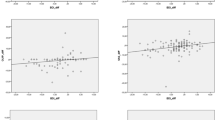Abstract
Background
A substantial proportion of Wilson’s disease (WD) patients exhibit residual neurological symptoms. Data on the prognostic value of initial clinical features and treatment choices in WD patients compliant to the therapy is relatively sparse.
Aim
The aim of the present study was to identify predictors of the long-term outcome of patients with WD with good treatment adherence.
Methods
Forty patients with neurological form of WD were evaluated before the de-coppering treatment initiation (based on the medical records) and after mean 15.25 ± 11.24 years of the stable treatment. Severity of neurological symptoms were assessed with a tier two of Global Assessment Scale (GAS) for Wilson’s Disease.
Results
The most frequent symptoms prior to treatment initiation were dysarthria (90%), tremor (90%), clumsiness (67.5%), depression (67.5%), and gait disturbance (62.5%). Significant decrease in the frequency of dysarthria, clumsiness, tremor, gait disturbance, postural instability and an improvement in school/work performance were observed after the long-term treatment, while frequency of dysphagia, drooling, bradykinesia and rigidity, dystonic and choreatic features did not change. Overall symptom severity decreased over time. Presence of dystonia before treatment initiation was the only identified predictor of worse residual GAS score. Greater severity of residual dystonia was associated with female gender and longer disease duration.
Conclusion
Although patients with neurological form of WD compliant to de-coppering treatment had favorable disease outcome, a significant burden of residual neurological symptoms was observed after the long-term follow-up. Dystonia at disease onset was the only identified predictor of the worse long-term outcome.

Similar content being viewed by others
Data Availability
Data used in this study is available upon request.
References
Bandmann O, Weiss KH, Kaler SG (2015) Wilson’s disease and other neurological copper disorders. Lancet Neurol 14:103–113. https://doi.org/10.1016/S1474-4422(14)70190-5
Weiss KH et al (2013) Efficacy and safety of oral chelators in treatment of patients with Wilson disease. Clin Gastroenterol Hepatol 11(1028–1035):e1021-1022. https://doi.org/10.1016/j.cgh.2013.03.012
Burke JF et al (2011) Prognostic significance of neurologic examination findings in Wilson disease. Parkinsonism Relat Disord 17:551–556. https://doi.org/10.1016/j.parkreldis.2011.05.002
Czlonkowska A et al (2018) Wilson disease. Nat Rev Dis Primers 4:21. https://doi.org/10.1038/s41572-018-0018-3
Svetel M et al (2009) Long-term outcome in Serbian patients with Wilson disease. Eur J Neurol 16:852–857. https://doi.org/10.1111/j.1468-1331.2009.02607.x
Pellecchia MT et al (2003) Clinical presentation and treatment of Wilson’s disease: a single-centre experience. Eur Neurol 50:48–52. https://doi.org/10.1159/000070858
Hefter H, Tezayak O, Rosenthal D (2018) Long-term outcome of neurological Wilson’s disease. Parkinsonism Relat Disord 49:48–53. https://doi.org/10.1016/j.parkreldis.2018.01.007
Prashanth LK et al (2005) Prognostic factors in patients presenting with severe neurological forms of Wilson’s disease. QJM 98:557–563. https://doi.org/10.1093/qjmed/hci095
Brewer GJ, Yuzbasiyan-Gurkan V (1992) Wilson disease. Medicine (Baltimore) 71:139–164. https://doi.org/10.1097/00005792-199205000-00004
Aggarwal A, Aggarwal N, Nagral A, Jankharia G, Bhatt M (2009) A novel Global Assessment Scale for Wilson’s Disease (GAS for WD). Mov Disord 24:509–518. https://doi.org/10.1002/mds.22231
Czlonkowska A et al (2018) Characteristics of a newly diagnosed Polish cohort of patients with neurological manifestations of Wilson disease evaluated with the Unified Wilson’s Disease Rating Scale. BMC Neurol 18:34. https://doi.org/10.1186/s12883-018-1039-y
Svetel M et al (2011) Quality of life in patients with treated and clinically stable Wilson’s disease. Mov Disord 26:1503–1508. https://doi.org/10.1002/mds.23608
Svetel M et al (2009) Neuropsychiatric aspects of treated Wilson’s disease. Parkinsonism Relat Disord 15:772–775. https://doi.org/10.1016/j.parkreldis.2009.01.010
Kalita J, Kumar V, Parashar V, Misra UK (2021) Neuropsychiatric Manifestations of Wilson Disease: correlation with MRI and Glutamate Excitotoxicity. Mol Neurobiol 58:6020–6031. https://doi.org/10.1007/s12035-021-02525-4
Palmieri GR et al (2022) Prevalence and features of non-motor symptoms in Wilson’s disease. Parkinsonism Relat Disord 95:103–106. https://doi.org/10.1016/j.parkreldis.2022.01.016
Svetel M et al (2001) Dystonia in Wilson’s disease. Mov Disord 16:719–723. https://doi.org/10.1002/mds.1118
Hou H et al (2022) Clinical and genetic analysis in neurological wilson’s disease patients with neurological worsening following chelator therapy. Front Genet 13:875694. https://doi.org/10.3389/fgene.2022.875694
Samanci B et al (2021) Neurological features and outcomes of Wilson’s disease: a single-center experience. Neurol Sci 42:3829–3834. https://doi.org/10.1007/s10072-020-05013-0
Ferenci P et al (2019) Age and sex but Not ATP7B genotype effectively influence the clinical phenotype of Wilson disease. Hepatology 69:1464–1476. https://doi.org/10.1002/hep.30280
Litwin T, Gromadzka G, Czlonkowska A (2012) Gender differences in Wilson’s disease. J Neurol Sci 312:31–35. https://doi.org/10.1016/j.jns.2011.08.028
Litwin T, Gromadzka G, Czlonkowska A, Golebiowski M, Poniatowska R (2013) The effect of gender on brain MRI pathology in Wilson’s disease. Metab Brain Dis 28:69–75. https://doi.org/10.1007/s11011-013-9378-2
Phukan J, Albanese A, Gasser T, Warner T (2011) Primary dystonia and dystonia-plus syndromes: clinical characteristics, diagnosis, and pathogenesis. Lancet Neurol 10:1074–1085. https://doi.org/10.1016/S1474-4422(11)70232-0
Prashanth LK, Taly AB, Sinha S, Arunodaya GR, Swamy HS (2004) Wilson’s disease: diagnostic errors and clinical implications. J Neurol Neurosurg Psychiatry 75:907–909. https://doi.org/10.1136/jnnp.2003.026310
Hu J, Lu D, Wang G (2001) Study on the clinical misdiagnosis of hepatolenticular degeneration. Zhonghua Yi Xue Za Zhi 81:642–644
Dubbioso R et al (2016) Subclinical neurological involvement does not develop if Wilson’s disease is treated early. Parkinsonism Relat Disord 24:15–19. https://doi.org/10.1016/j.parkreldis.2016.01.024
European Association for Study of L (2012) EASL clinical practice guidelines: Wilson’s disease. J Hepatol 56:671–685. https://doi.org/10.1016/j.jhep.2011.11.007
Wiernicka A et al (2017) Early onset of Wilson disease: diagnostic challenges. J Pediatr Gastroenterol Nutr 65:555–560. https://doi.org/10.1097/MPG.0000000000001700
Caca K et al (2001) High prevalence of the H1069Q mutation in East German patients with Wilson disease: rapid detection of mutations by limited sequencing and phenotype-genotype analysis. J Hepatol 35:575–581. https://doi.org/10.1016/s0168-8278(01)00219-7
Gromadzka G et al (2006) p.H1069Q mutation in ATP7B and biochemical parameters of copper metabolism and clinical manifestation of Wilson’s disease. Mov Disord 21:245–248. https://doi.org/10.1002/mds.20671
Czlonkowska A et al (2014) D-penicillamine versus zinc sulfate as first-line therapy for Wilson’s disease. Eur J Neurol 21:599–606. https://doi.org/10.1111/ene.12348
Funding
No funding was received for conducting this study. Marina Svetel, Nikola Kresojević, Milica Ječmenica Lukić, Igor Petrović, Nataša Dragašević-Mišković, have received a speaker honorarium from Salveo. Iva Stanković, Čarna Jovanović, Jelena Vitković, Tatjana Pekmezović, Aleksandra Tomić, Vladana Marković and Vladimir Kostić have nothing to disclose.
Author information
Authors and Affiliations
Contributions
Conceptualization: MS, VK. Methodology: MS, VK, ND, TP. Formal analysis and investigation: IS, MJL, CJ, JV. Writing–original draft preparation: IS, NK, AT, VM, MJ. Writing–review and editing: MS, TP, IP, ND, VK. Funding acquisition: /Resources: /Supervision: MS, IP, ND, VK.
Corresponding author
Ethics declarations
Conflicts of interest
Marina Svetel, Nikola Kresojević, Milica Ječmenica Lukić, Igor Petrović, Nataša Dragašević-Mišković, have received a speaker honorarium from Salveo. Iva Stanković, Čarna Jovanović, Jelena Vitković, Tatjana Pekmezović, Aleksandra Tomić, Vladana Marković and Vladimir Kostić have nothing to disclose.
Rights and permissions
Springer Nature or its licensor (e.g. a society or other partner) holds exclusive rights to this article under a publishing agreement with the author(s) or other rightsholder(s); author self-archiving of the accepted manuscript version of this article is solely governed by the terms of such publishing agreement and applicable law.
About this article
Cite this article
Stanković, I., Jovanović, Č., Vitković, J. et al. Long-term outcome of patients with neurological form of Wilson’s disease compliant to the de-coppering treatment. J Neurol 270, 3492–3498 (2023). https://doi.org/10.1007/s00415-023-11681-7
Received:
Revised:
Accepted:
Published:
Issue Date:
DOI: https://doi.org/10.1007/s00415-023-11681-7




